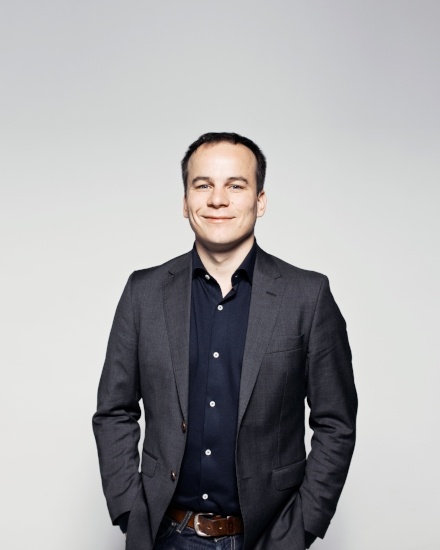The Data Handbook
How to use data to improve your customer journey and get better business outcomes in digital sales. Interviews, use cases, and deep-dives.
Get the book In a traditional organisation, talent needs to learn new things to ensure that the organisation can keep up with its customers and the rest of the world. As Digital Director & Head of Data with UPM, Heikki Yrjölä is embracing the necessary changes and methodology that are ahead of him.
In a traditional organisation, talent needs to learn new things to ensure that the organisation can keep up with its customers and the rest of the world. As Digital Director & Head of Data with UPM, Heikki Yrjölä is embracing the necessary changes and methodology that are ahead of him.

Interviewee: UPM | Heikki Yrjölä, Digital Director
What is the role of digital at UPM?
Heikki: We are working hard to internally prove the value of digital and to show how it benefits customers. We are constantly looking for more proof points, numbers and data to justify more investments in marketing. Often we need to bring sales and marketing closer together to be able to demonstrate the value of improvements through the whole funnel.
We already see value in self-service, as our customers prefer to self-serve and handle their orders, as opposed to going through the process of us calling them in.
How do you see the future of UPM in the next few years in terms of digital IT?
Heikki: I’d like to see us bring the silos down. For instance, IT, sales and marketing have traditionally worked quite separately from each other, but digital development requires a new kind of collaboration.
IT means different things in different companies and I think the difference between IT and digital is interesting. Traditional IT has been about delivering and maintaining technical platforms. To me, “digital” means delivering business value using these platforms, so it also includes things like the business case, processes, users and design. Building the organisational capabilities to deliver all of this is a big change for a large organisation.
In a company with multiple business units, I’d like to see us get to a point where IT has a full digital understanding with a holistic view across the businesses. Otherwise, we risk reinventing the wheel project after project and doing so in all our business units.
Getting truly digital also requires wider developments in culture and organisational capabilities. I believe we need to get some basic elements of agile methodology and user-centricity into our DNA. With a large company like UPM, for us to drive the change, we need to constantly demonstrate success through examples to justify taking the learnings to the other teams as well.
How is customer experience considered in your IT?
Heikki: IT’s role has traditionally been purely technical: providing the technology, managing suppliers, keeping the platforms steady and so on. Those are vital tasks, but customer focus and digital understanding are needed too. When I consider the difference between traditional IT and digital, I think of service management vs. product management. Service management is about capacity, code and SLAs. Product management is about users, transactions and experience.
We still have work to do to be customer-experience focused on our platforms — ensuring the technology delivers business value. A digital platform is just a platform when it’s installed, but developing all the processes, seeing how people use it, comparing its benefits to an earlier system and so on — that’s where I would like to see us going.
To efficiently collaborate across the traditional silos, IT should align their targets on common metrics set on business value, obviously in addition to the traditional metrics that they have had. For a platform to truly deliver business value, it’s not enough that it’s up and running. It also needs to attract and serve users.
What about the value of digital when it comes to UPM’s sales teams?
Heikki: There’s still plenty of development and innovation to be done around utilising digital in sales. There’s a lot of variation between our business units, but in the largest B2B industries where we operate, the customer demand for digital services hasn’t yet reached its peak either.
In 2021, I’d like to see us start innovating how our traditional products like paper and pulp are being bought in the next 10 years. The customers might not ask anything special right now, but their digital requirements will increase over time and as new generations join those companies.
One gut feeling I have is that all sales teams should have a CRM enthusiast — somebody who is interested in developing the setup in the CRM and considering the business processes end-to-end. This way, our salespeople who are using and relying on it would continually develop the process based on their needs. That’s what I’d like to see UPM move toward — having a business driver for all platforms.
Then there’s the whole question of developing the customer experience. How can we make sure that the experience is logical and coherent when the customers are dealing with our marketing, sales and customer service? And how do we best align the development of our sales processes and digital services towards that same experience?
What have been some of the effects of the global pandemic on your organisation at UPM?
Heikki: COVID-19 has changed things for us quite a lot. Events played such a large role in our marketing before the pandemic’s arrival, and those events have now either been cancelled or moved online. Webinars and digital marketing have moved to the front.
Our sales teams have been requesting more webinars and they can now see the value of online events in a new and positive way. With UPM’s event exposure reduced, sales have also been taking part in organising online events and learning more about digital marketing.
The switch to remote working has also taught people many things. Everyone has had to become better with basic digital communications and tools. And managers have had to take a new look at how to keep their teams motivated in a different setup.
What has been the biggest challenge in getting the data in place throughout the whole customer journey?
Heikki: We have begun the work of establishing a common data platform for all business units at UPM. The focus of our digitalisation journey so far has been on efficient production and the supply chain. Now my interest is to get more data about how customers purchase and use our products. We want to make the whole experience as smooth as possible and innovate to take the whole forest-based industry forward.
At UPM, we use the same raw material to do many things. We also get some of our waste back to produce something else, in a circular economy. This is where data may provide great new opportunities, because the same material goes around.
In a business of large volumes, it’s also always useful to be able to predict market changes and price correctly. This is where combining data from across our different business areas may enable us to find common patterns and new signals. It is certainly an interesting area in the next stage of digitalisation for us.
Any final thoughts to share on the digital sales journey that’s ahead of you?
Heikki: A lot of change will involve bits of agile methodology. Most of the people I talk to are eager and happy to learn agile working practices. When they get the training and begin to draft the business value, they discover the reasons to experiment and move more quickly. It’s quite motivating and inspiring. And it will help to push a total change to the digital culture at UPM.
In any walk of life, when the world changes, we have to adjust. For our journey, the key is understanding that new platforms and processes need clear ownership. Often new things fall between traditional organisational structures and responsibilities, so you need to be ready to adjust. And when people have the ownership, they need the mandate to push development. Change is inevitable and natural — and should be praised.
This blog post is part of the Digital Sales Handbook for leaders in IT. The Handbook is a crystallisation of the key themes leaders in IT need to understand in 2021 to push their digital-enabled sales forward. The book includes interviews with industry experts from companies including Stora Enso, SAS, UPM and Tiger of Sweden. Learn how your IT can become an active driver for digital sales!
The Data Handbook
How to use data to improve your customer journey and get better business outcomes in digital sales. Interviews, use cases, and deep-dives.
Get the book




